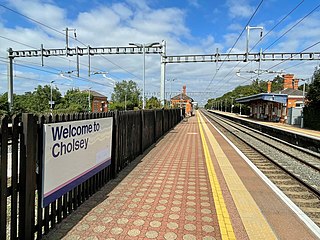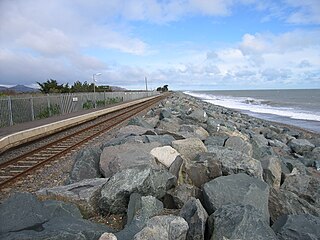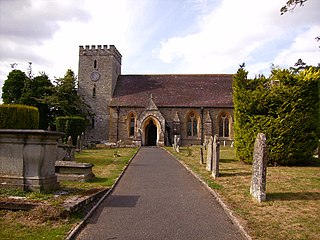
Heathrow Express is a high-frequency airport rail link operating between London Heathrow Airport and London Paddington. Opened in 1998, trains run non-stop, with a journey time of 15 minutes. The service is operated jointly by Great Western Railway and Heathrow Express Operating Company, a wholly owned subsidiary of Heathrow Airport Holdings.

Kington is a market town, electoral ward and civil parish in Herefordshire, England. The ward had a population of 3,240, while the 2011 Census registered a population of 2,626.

Presteigne is a town and community in Radnorshire, Powys, Wales on the south bank of the River Lugg. Formerly the county town of the historic county of Radnorshire, the town has, in common with several other towns close to the Wales-England border, assumed the motto, "Gateway to Wales". The border wraps around three sides of the town. Nearby towns are Kington, Herefordshire to the south and Knighton to the north, and surrounding villages include Norton and Stapleton. The town falls within the Diocese of Hereford. The community has a population of 2,710; the built-up area had a population of 2,056.

The Dean Forest Railway is a 4+1⁄4-mile (6.8 km) long heritage railway that runs between Lydney and Parkend in the Forest of Dean, Gloucestershire.

Cholsey railway station serves the village of Cholsey in south Oxfordshire, England, and the nearby town of Wallingford. It is 48 miles 37 chains (78.0 km) down the line from London Paddington and is situated between Goring & Streatley to the east and Didcot Parkway to the west.

Heathrow Connect was a train service in London provided jointly by Heathrow Express and Great Western Railway (GWR), between Paddington station and Heathrow Airport. The service followed the same route as the non-stop Heathrow Express service but called at certain intermediate stations, connecting several locations in West London with each other, the airport, and Central London. It ran every half-hour throughout the day and evening. The service was launched on 12 June 2005 and ceased on 19 May 2018, when it was absorbed into the TfL Rail concession, in advance of becoming part of the Elizabeth line once it opened on 24 May 2022.

Leominster railway station lies on the Welsh Marches Line serving the Herefordshire town of Leominster in England. It is situated 11+1⁄4 miles (18.1 km) north of Hereford.

The London station group is a group of 18 railway stations served by the National Rail network in central London. The group contains all 14 terminal stations in central London, either serving major national services or local commuter routes, and 4 other through-stations that are considered terminals for ticketing purposes. All current stations in the group fall within London fare zone 1. A ticket marked "London Terminals" allows travel to any station in the group via any permitted route, as determined by the National Routeing Guide.

The Mid-Cheshire line is a railway line in the north-west of England that runs from Chester to Edgeley Junction, Stockport; it connects Chester with Manchester Piccadilly, via Knutsford. After Chester Northgate closed in 1969, the section between Mickle Trafford Junction and Chester was used for freight trains only until it closed in 1992; from Mickle Trafford, passenger trains use the Chester–Warrington line to Chester General instead. The route taken by passenger trains has changed over the years and now differs considerably from the original. Between 2001 and 2014, passenger journeys on the line increased to over 1.7 million per year. A near doubling of the passenger service was expected to occur from December 2018, however this did not materialise.
The Ruabon–Barmouth line was a standard-gauge line owned by the Great Western Railway across the north of Wales which connected Ruabon, in the east, with Barmouth on the west coast.
Hereford has seen a history of expansion and decline in its railway history.

The Dublin-Rosslare Main Line is a main rail route between Dublin Connolly station and Rosslare Europort, where it connects with ferry services to the United Kingdom and mainland Europe. The line between Dublin and Greystones is electrified and forms the southern part of the DART service. Between Bray and Rosslare the line is single track only. The line connected with the Limerick–Rosslare line outside Rosslare Strand until 2010. From Wicklow on, semaphore signalling was used until April 2008, when the entire line was upgraded to the mini-CTC system controlled from Dublin Connolly. Although it is designated as a separate route, the line is continuous after Dublin Connolly, where it connects with the Belfast–Dublin main line. The section between Westland Row and a point on the line just after Salthill and Monkstown station is the oldest railway line in Ireland, and the first commuter railway in the world, opening in 1834. It was then known as the Dublin & Kingstown Railway. At that time, the railway terminated adjacent to the start of Dún Laoghaire Harbour's West Pier, at a station called Kingstown.

Llanidloes railway station is a former junction railway station in Llanidloes, Powys, Wales. The Cambrian Railways, which completed the building in 1864, designed it to be both the station for the town and its company headquarters. This dual purpose gave Llanidloes station an imposing appearance.

Titley is a village and civil parish in Herefordshire, England. It lies on the B4355 between Kington and Presteigne.

Titley Junction railway station was a station in Titley, Herefordshire, England. The station was located nearly two miles south of Titley village.
Leominster and Kington Railway was one of four branches which served the Welsh Marches border town of Kington, Herefordshire.
The Kington and Eardisley Railway took over the Kington Tramway, which served the Welsh Marches border town of Kington, Herefordshire. In 1874 it opened a 6 miles 72 chains (11.1 km) line south from Titley Junction to a junction with the Hereford, Hay and Brecon Railway, 5 chains east of Eardisley. A year later it replaced the remainder of the tramway with a branch west to New Radnor. Between these two branches it had running powers on the Titley Junction to Kington section of the Leominster and Kington Railway. The Eardisley branch closed in 1940, the New Radnor branch in 1951.

New Radnor railway station was a station in New Radnor, Powys, Wales. The terminus station opened in 1875 and closed in 1951.
Forge Crossing Halt railway station was a station in Titley, Herefordshire, England. The station, on the Presteigne Branch Line of the Leominster and Kington Railway, was opened in 1929 and closed in 1951.

Staunton on Arrow is a village and civil parish in the county of Herefordshire, England. The village is 17 miles (27 km) north-west of Hereford and 8 miles (13 km) to the west of Leominster. Within the parish is the site of the Iron Age hill fort of Wapley Hill.















